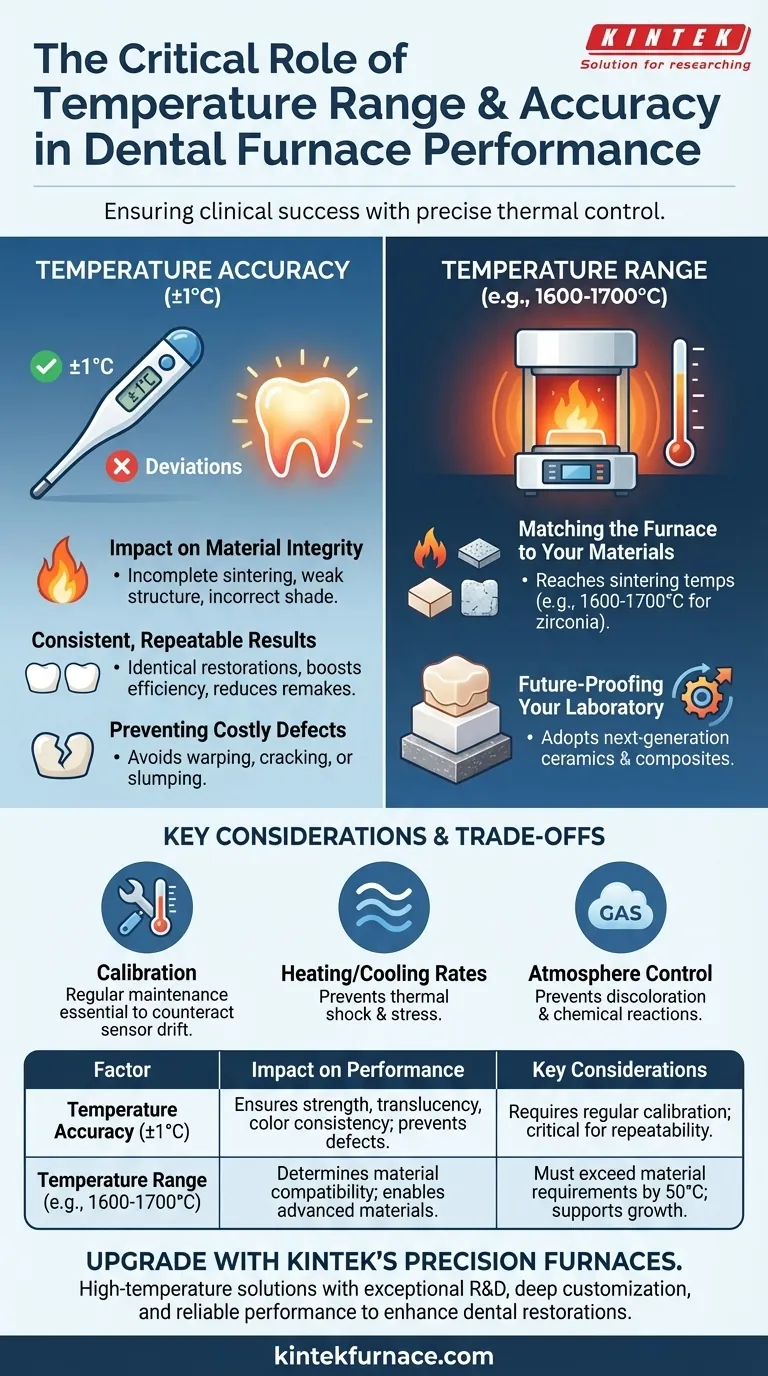In dental fabrication, temperature range and accuracy are the two most critical performance indicators of a dental furnace. Accuracy, ideally within ±1°C, ensures the physical and aesthetic properties of a restoration are correctly developed, while the temperature range dictates which advanced materials, like zirconia, the furnace is capable of processing.
The core issue is not simply the furnace's technical specifications, but how those specifications directly translate to clinical success. Inaccurate temperature control leads to costly remakes and inconsistent quality, while an inadequate temperature range limits your lab's ability to work with modern, high-performance materials.
Why Temperature Accuracy is Non-Negotiable
A furnace’s ability to precisely hit and hold a target temperature is the foundation of a successful restoration. Even minor deviations can have significant consequences.
The Impact on Material Integrity
Dental materials like ceramics and zirconia undergo specific phase changes at precise temperatures. This process, known as sintering, is what gives the final restoration its strength, translucency, and color.
A temperature deviation of even a few degrees can result in incomplete sintering, leading to a weak, porous structure or an incorrect shade that fails to match the patient's teeth.
Ensuring Consistent, Repeatable Results
High accuracy (±1°C or better) ensures that the first restoration and the one-hundredth restoration are identical. This predictability is vital for a dental lab's efficiency and reputation.
Inconsistency forces technicians into a cycle of trial-and-error, wasting valuable materials, time, and money on remakes.
Preventing Costly Defects
Temperature fluctuations are a primary cause of physical defects. Too rapid a change or an inaccurate holding temperature can cause warping, cracking, or slumping in the restoration.
A furnace with proven accuracy is your best defense against these common but preventable failures.
The Strategic Importance of Temperature Range
While accuracy ensures quality, the temperature range determines capability. It defines the palette of materials your laboratory can work with.
Matching the Furnace to Your Materials
Different materials require vastly different processing temperatures. For example, many modern zirconia formulations require sintering temperatures between 1600°C and 1700°C to achieve their optimal strength and translucency.
If a furnace cannot reliably reach and sustain these temperatures, it simply cannot process these materials correctly, rendering it obsolete for a modern dental workflow.
Future-Proofing Your Laboratory
The field of dental materials is constantly evolving. Investing in a furnace with a wide temperature range ensures your lab is prepared to adopt next-generation ceramics and composites as they become available.
A limited range may save costs initially but can quickly become a bottleneck that restricts your lab's growth and service offerings.
Understanding the Trade-offs and Key Considerations
Evaluating a furnace goes beyond reading a spec sheet. True performance is a combination of design, maintenance, and operator understanding.
The Critical Role of Calibration
A furnace is only as accurate as its last calibration. Over time, heating elements and temperature sensors (thermocouples) degrade, causing a drift in temperature accuracy.
Regular, proactive calibration is not an optional task; it is essential maintenance required to guarantee the performance you paid for and ensure consistent clinical outcomes.
Beyond Range and Accuracy
While critical, temperature is just one piece of the puzzle. The heating and cooling rates are equally important, as they prevent thermal shock and stress.
Furthermore, some processes may require specific atmosphere control to prevent discoloration or unwanted chemical reactions. A holistic view of the furnace's capabilities is necessary.
Making the Right Choice for Your Goals
Your selection should be guided by the specific needs of your laboratory and your long-term strategic vision.
- If your primary focus is high-volume production with specific materials: Prioritize a furnace with documented ±1°C accuracy and a range that comfortably exceeds your current material's requirements by at least 50°C.
- If your primary focus is versatility and R&D: Prioritize a furnace with the widest possible temperature range to ensure compatibility with future and experimental materials.
- If your primary focus is long-term reliability and minimal downtime: Prioritize a furnace from a manufacturer that offers straightforward calibration procedures and robust technical support, such as remote diagnostics.
Ultimately, mastering your furnace's temperature control is mastering the quality and consistency of your final restorations.
Summary Table:
| Factor | Impact on Performance | Key Considerations |
|---|---|---|
| Temperature Accuracy (±1°C) | Ensures strength, translucency, and color consistency in restorations; prevents defects like warping and cracking. | Requires regular calibration; critical for repeatable results and cost savings. |
| Temperature Range (e.g., 1600-1700°C for zirconia) | Determines material compatibility; enables processing of advanced ceramics and future-proofs the lab. | Must exceed material requirements by 50°C; supports versatility and growth. |
Upgrade Your Dental Lab with KINTEK's Precision Furnaces
Leveraging exceptional R&D and in-house manufacturing, KINTEK provides diverse laboratories with advanced high-temperature furnace solutions. Our product line, including Muffle, Tube, Rotary Furnaces, Vacuum & Atmosphere Furnaces, and CVD/PECVD Systems, is complemented by strong deep customization capability to precisely meet unique experimental requirements. Whether you need ±1°C accuracy for consistent results or a wide temperature range for material versatility, we deliver reliable performance that reduces remakes and boosts efficiency. Contact us today to discuss how our furnaces can enhance your dental restorations and support your lab's long-term success!
Visual Guide

Related Products
- Chairside Dental Porcelain Zirconia Sintering Furnace with Transformer for Ceramic Restorations
- Dental Porcelain Zirconia Sintering Ceramic Vacuum Press Furnace
- Laboratory Muffle Oven Furnace with Bottom Lifting
- 1700℃ Controlled Inert Nitrogen Atmosphere Furnace
- 1700℃ High Temperature Laboratory Tube Furnace with Quartz or Alumina Tube
People Also Ask
- What are some key features of dental sintering and porcelain furnaces? Optimize Your Dental Lab's Workflow
- Why is accurate temperature control important in dental furnaces? Ensure Perfect Restorations Every Time
- What are the recommended maintenance practices for dental furnaces? Ensure Precision and Longevity for Your Lab
- What is the importance of dental furnaces in dentistry? Ensure Strong, Precise Dental Restorations
- What is sintering in dental? The Key to Durable, High-Strength Zirconia Restorations



















